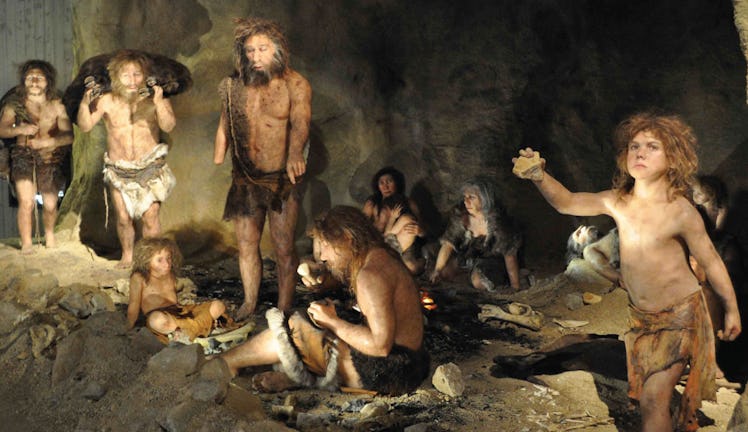Why Prehistoric Parenting Wasn’t As Primitive As You Might Think
Stone ages and stages.

You might think of 12,000 BCE, when the Neanderthals were checking out and those big-brained, socially organized homo sapiens were checking in, as a simpler time. Kids looked at stars instead of screens; if you were hungry, you just killed something and ate it; and work-life balance wasn’t really a thing. Then again, parents had to deal with a staggering mortality rate and big creatures that wanted to eat them. It’s kind of amazing that they managed to raise anyone to adulthood, and it’s even more amazing that some of their parenting techniques are not only still in use today — they’re the techniques of choice in certain Brooklyn neighborhoods.
Kids Were Attached At The Hip
Daycare in 12,000 BCE was called strapping ‘em on your back (or chest) and going about your day. The benefits of that practice meant more than just not worrying about getting your kid into the right preschool; some psychologists believe all that carrying and cuddling set prehistoric kids up to be more empathetic and emotionally intelligent later in life. It’s the same theory behind the skin-to-skin contact your doctor insisted you get with your newborn, because it’s crucial for still-developing infant brains. Of course, the bar was set pretty low. Back then a sign of high EQ was not bashing your neighbor’s head in with a rock.
It Took A Prehistoric Village
Paleolithic dads might have been more involved than you’d think. If adults lived anywhere near kids in that epoch, you were essentially a surrogate parent. And while that all sounds like some proto-hippie stuff, it was less a “f*ck you” to their square parents and more just practical for all the parents in the tribe.
Early humans realized that if you were exhausted, you’d be less equipped to pitch in with the needs of the tribe, so there was a lot of trading off duties. And while the earlier Neanderthals had everyone do everything, it was Homo sapiens who starting assigning things like hunting and gathering by gender. Say what you will about that stone ceiling, it did prevent humans from going extinct.
School Was Other Children
If you thought that Montessori was liberal, in this society playtime wasn’t structured by age group — or anything, really. Prehistoric kids benefitted from exposure to peers at all different stages of development, and had more room for what those in the modern era would call “imaginative play.” Childhood development experts believe that’s essential for warding off mental health issues and ADHD, although it’s not so good for warding off sabretooth tigers.
“Cry It Out” Wasn’t A Thing
You’re probably wondering: How could crying infants ever survive with all that wailing attracting baby-hungry beasts? It wasn’t as big a problem as you might think. Instead of lying perfectly still and praying to a monotheistic God that wasn’t invented yet, these parents rolled over and handled it at any hour of the night because their entire family was co-sleeping together.
There’s that modern theory that letting a kid “cry it out” teaches them to self-sooth, but some psychologists believe paying attention to crying kids the way Prehistoric parents did actually pays off over time. Eventually, they learn to calm themselves down, and researchers say having responsive parents might have helped them develop a conscience earlier and made them more agreeable.
Breastfeeding Until Those Baby Teeth Are Gone
That mom who still nurses her kid that can write their name? She would have made a great cavewoman. Anthropologists say that back in the day, nursing kids past their first birthday (and up to 2-4 years old) was de rigour.
It’s hard to nail down the exact age purely from fossil records, but based on variations found in hunter-gatherer societies (and looking at how our ape relatives do it) they have a pretty good idea. Prehistoric humans also didn’t have the luxury of equally shared parenting roles and organic food pouches to start weaning their kids earlier.
What A Legit Paleo Diet Looks Like
Gluten-free? Lactose-intolerant? Nut allergies? If you wanted to feed your child a “paleo” diet, it’s not as much of the meat and fish and vegetables your gym buddy swears by. For one thing, prehistoric animals were not as plump and juicy as what you find in the meat aisle.
But, like you, Paleolithic people still had a hard time getting their kids to finish their veggies. Of course, vegetables back then were tiny and may kill you: Peanut-sized potatoes, spiny cucumbers, too-bitter-to-eat leafy greens, and beans naturally filled with cyanide — which is still how a toddler looks at a salad.
What Paleolithic families did eat was largely dependent on their location. Desert-dwellers wouldn’t have access to fish. Homo sapiens in colder areas couldn’t get fruits and vegetables even if they wanted them. So “healthy” mostly meant eating enough to survive. Most Prehistoric kids died before age 15, and adults typically didn’t live past 40. With that knowledge, you never have to feel guilty about letting your kid snap into a Slim Jim again.
This article was originally published on